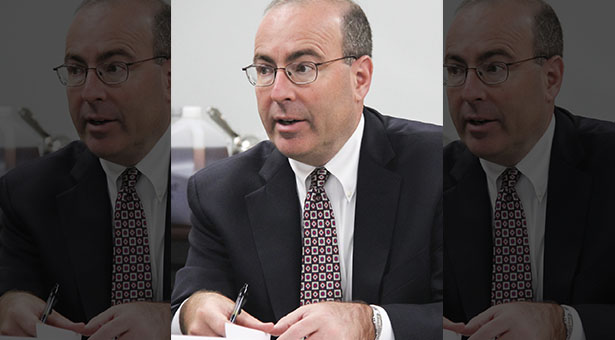Above: Richmond Fed President Tom Barkin. PHOTO BY KERI STEGALL
Most people know the Federal Reserve Bank only as the “up-a-quarter-point, down-a quarter-point” institution. But, armed with a broader mandate and a serious question, Richmond Fed President and CEO Tom Barkin visited Abingdon, Va., Aug. 5 to hear from business, not-for-profit, and government leaders about the regional economy.
“Our mandate includes stable prices, but it very much includes maximum employment,” Barkin explained. “We’re in a very interesting situation in the economy, where unemployment is as low as it’s been in 50 years, but we’re not seeing prices go unstable. So, we’re testing the question of, ‘How far can our labor market go before you start to get the kind of tightness that works the wrong way?”
“Workforce development is a topic the Richmond Fed is very interested in,” Barkin said. Southwest Virginia is of particular interest because of the apparent disconnect between high quality K-12 education in rural communities and relatively high unemployment in those same communities.
“I was looking at employment-to-population, and Washington County, Va., does pretty well on a national status, but the counties that surround Washington County, less well,” Barkin said. “So, I am interested in understanding what works here and what doesn’t.”
“I have the sense that the school systems here are pretty good,” Barkin continued. “In fact, the stats I’ve seen indicate they’re much better here than in other parts of the state. But also, if it’s much better here than in other parts of the state, then what am I missing? What’s the secret sauce that will get you the rest of the way to increasing employment outcomes?”
One answer Barkin heard centered around state funding models, which allow richer school districts to construct new facilities while making it virtually impossible to do so in poorer rural districts. Almost every school building in rural Southwest Virginia was built during the Eisenhower or Kennedy administrations, Delegate Israel O’Quinn told Barkin.
When potential employers are driving through the region on site visits, they see those buildings and dismiss the notion that their employees will want their children to attend those schools, despite the very high academic performance generated there.
In addition, a large percentage of graduates leave the region because of the lack of diversity in the economy.
“This question of talent leaving the market became a lot clearer to me today,” Barkin said after the event. “You have a very good system with very good performance, and then a market where performance isn’t consistent with that of the education system. The reason it’s not is that a lot of talented people graduate from here and leave. So, I think the interesting question for me is, ‘what does it take for markets like this to bring people back?’”
One answer to that question was to incentivize them never to leave in the first place. United Way of Southwest Virginia President and CEO Travis Staton gave Barkin an overview of the Ignite program, which sparks career interest in the next generation of the workforce through career awareness and skill development. “The program helps bridge the gap between the worlds of learning and work by connecting schools and students with employers and employees,” Staton said. “This summer the Ignite Program connected 38 students to internship opportunities with local employers, helping students build their employability skills including teamwork, communication, and professionalism.”
“It is encouraging to hear about initiatives such as United Way of Southwest Virginia’s Ignite Program and how communities are working to improve opportunities for students,” Barkin said. “I got clear in my mind the strength of the education system here and some of the rationale for it – the cohesion and support of the civic leaders in their support of it. It was very interesting to hear some of the stuff the United Way is doing. That is very helpful in terms of programs that are working here because I am constantly trying to take good practices to other places.”

